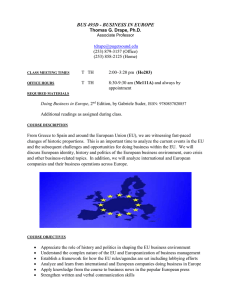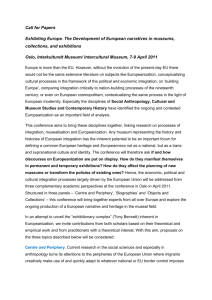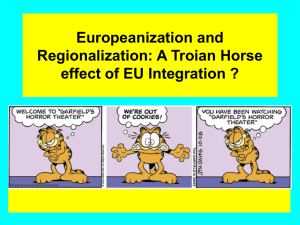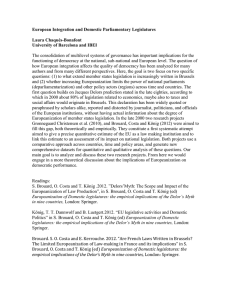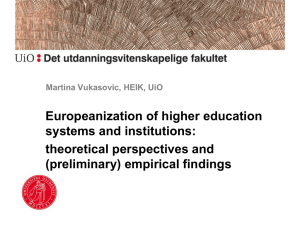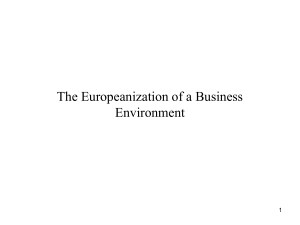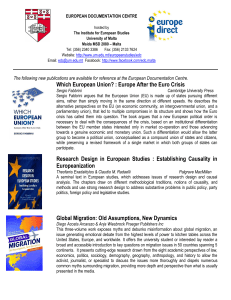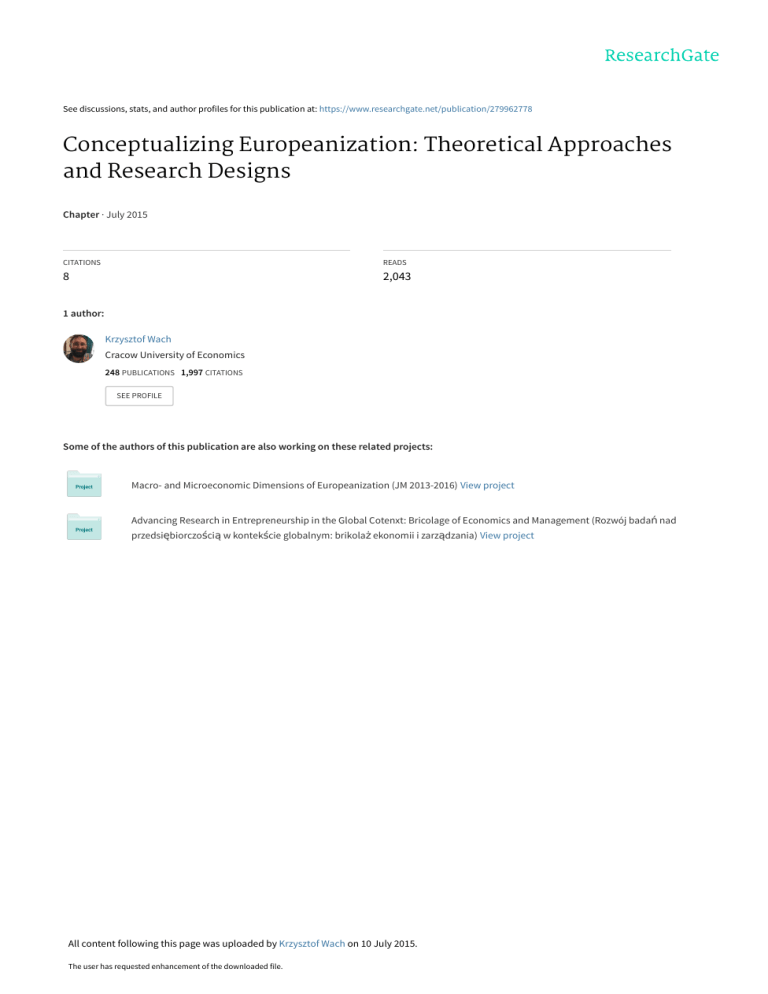
See discussions, stats, and author profiles for this publication at: https://www.researchgate.net/publication/279962778 Conceptualizing Europeanization: Theoretical Approaches and Research Designs Chapter · July 2015 CITATIONS READS 8 2,043 1 author: Krzysztof Wach Cracow University of Economics 248 PUBLICATIONS 1,997 CITATIONS SEE PROFILE Some of the authors of this publication are also working on these related projects: Macro- and Microeconomic Dimensions of Europeanization (JM 2013-2016) View project Advancing Research in Entrepreneurship in the Global Cotenxt: Bricolage of Economics and Management (Rozwój badań nad przedsiębiorczością w kontekście globalnym: brikolaż ekonomii i zarządzania) View project All content following this page was uploaded by Krzysztof Wach on 10 July 2015. The user has requested enhancement of the downloaded file. Suggested Citation: Wach, K. (2015). Conceptualizing Europeanization: Theoretical Approaches and Research Designs (chapter 1). In: P. Stanek & K. Wach (Eds.). Europeanization Processes from the Mesoeconomic Perspective: Industries and Policies. Kraków: Cracow University of Economics, pp. 11-23. 1 Conceptualizing Europeanization: Theoretical Approaches and Research Designs Krzysztof Wach Cracow University of Economics Faculty of Economics and International Relations Department of Entrepreneurship and Innovation ul. Rakowicka 27, 31-510 Kraków, Poland e-mail: wachk@uek.krakow.pl Summary: This chapter attempts to systematize and delimit the process of Europeanization as the scientific coin. The three main conceptual approaches to research on the process of Europeanization are discussed (namely bottom-up, top-down and circular approach). The various research on the phenomenon of Europeanization were analysed, which resulted in highlighting four main research approaches (polyvalent approach, casual approach, process approach and approach effect). The dimensions in which the Europeanization processes occur, are also indicated by highlighting and analysing the ten main dimensions of both economic and non-economic processes of the Europeanization. This chapter is a kind of the introduction to the theme of Europeanization. In addition to the discourse on the definition of Europeanization, the attempt its attempt to synthesize basic research approaches on this subject was included. The study is based on a typical literature review using the conventional research methods of deduction, reduction, synthesis and theoretical modelling. Keywords: Europeanization; European Union (EU); European integration; top-down; bottom-up JEL classification: F02, F15, D02, D79 This study was prepared under the project no. 542456-LLP-1-2013-1-PL-AJM-MO entitled ‘Macro- and Microeconomic Dimensions of Europeanization’ co-financed by the European Commission in the years 2013-2016. 1.1. INTRODUCTORY REMARKS Today Europeanization is a notion that is very frequently used, however, there is a clear shortage of, or even fragmentariness of scientific knowledge, within this scope. The research into the Europeanization processes were initiated by political scientists in the 1970s, although the notion itself gained in popularity 12 Krzysztof Wach only in the 1990s alongside the realization of the uniform Single European Market SEM (Wach, 2010). From that moment, Europeanization is a willingly undertaken research problem that has attracted interest in numerous fields and scientific disciplines. Floyd (2001, p. 109) emphasizes the fact that the majority of market changes which have occurred at the turn of the centuries since the beginning of the twenty-first century took place as a result of the Europeanization processes which are explicite, defined as the phenomenon of the regionalization processes. As Fligstein (2009, p. 107) highlights: “majority of the research concerning the European integration focuses only on political and legal processes (…) which is the reason for which researchers overlook the fact how deep the European economy has been reorganized”. There are few works of the kind cited above, are sparse, and in addition nor have there been many recent papers postulating seeking to undertake broad and deep research into the Europeanization processes in both economic (including macro-, meso- and microeconomic fields) and noneconomic dimensions. This chapter is a kind of the introduction to the theme of Europeanization. In addition to the discourse on the definition of Europeanization, its attempt to synthesize basic research approaches on this subject was included. This article attempts to systematize and delimit the process of Europeanization as the a scientific term. The three main conceptual approaches to research on the process of Europeanization are discussed (namely bottom-up, top-down and the circular approach). The various research results on the phenomenon of Europeanization have been analysed, which has resulted in highlighting four main research approaches (the polyvalent approach, casual approach, process approach and approach effect). The dimensions in which the Europeanization processes occur, are also indicated by highlighting and analysing the twelve main dimensions, both economic and non-economic processes, of Europeanization. 1.2. THREE WAVES OF EUROPEANIZATION RESEARCH Moravcsik (1994), Sandholtz (1996) and Kohler-Koch (1996) are regarded the main precursors of the Europeanization concept. Their concepts were established in the European integration theory and fell to 1990s. The first of them, being a representative of the stream of intergovernmentalism within the regional integration theory, is considered to be the author of the bottom-up or downloading approach explaining an influence of the integration processes on individual countries (Moravcsik, 1994). On the other hand, Sandholtz’s views in this respect were even of adversative character in comparison with Moravcsik’s views. In his opinion, integration creates new opportunities for domestic entities, resulting in institutional changes and the changes in shaping and conducting individual policies. The solution bases on the multi-level management system and is identical with the top-down approach (Sandholt, 1996, pp. 403–429). The third parallel concept, Conceptualizing Europeanization: Theoretical Approaches and Research … 13 developed by Kohler-Koch (1996, pp. 359–380), is based on the idea of the transformation of governance. When ordering the concepts of Europeanization chronologically, we should mention two more figures here. In mid-1990s, Ladrech (1999, pp. 69–88) provided one of the first acknowledged definitions of Europeanization, and Radaelli (1997, pp. 553–575; 2000), is regarded one of the major conceptuologists and propagators of the research into Europeanization, along with figures such as Börzel and Risse (2000). After a few years of his own studies and analyses, Olsen (2002) asked a question what exactly Europeanization is and whether this concept is scientifically useful. After a decade from posing this question for the first time it still remains open, and the forming literature on that is clearly fragmentary. We can assume that creating the scientific bases of Europeanization was an answer to the common use of this term, namely, de facto the methodology of empiricism (of empirical school) was adopted here from management studies. Thus, the concept of Europeanization in the literature of the subject is defined as “a phenomenon without origin” (Gellner & Smith, 1996, pp. 357–370). Nowadays, the term of Europeanization more and more often refers to the European Union itself rather than to Europe, or the European civilisation, which constitutes distortion of the etymology of this term, thus, some authors postulate to separate Europeanization and EU-ization, however, the great majority of researchers apply those terms interchangeably or, which happens more commonly, only the first term is used. For example, Ladrech (1999, p. 71) treats Europeanization as “an incremental process reorienting the direction and shape of politics to the degree that EC political and economic dynamics become part of the organisational logic of national politics and policy-making”, nota bene it is one of the first acknowledged definitions of Europeanization. Similarly, Börzel (1999, p. 574) interprets the phenomenon as “a process by which domestic policy areas become increasingly subject to European policy-making”. Bulmer and Burch (2001, p. 73) treat Europeanization very similarly as “a set of processes through which political, social and economic dynamics of the European Union displays interactions with Figure 1.1. Europeanization processes as the mechanisms of European integration Source: adapted from Howell (2005, p. 382). 14 Krzysztof Wach the logics of national discourse, national identity, domestic political structures and domestic public politicians”. In the research into the Europeanization process we can, after Holzhacker and Haverland, (2006, pp. 1–18), distinguish three waves which de facto constitute three generations of European studies (studies into the European integration), the result of which is the formation of separate, structured theoretical and conceptual framework for Europeanization as an arising separate research field. The first of them is the bottom-up approach, the second is top-down approach, whereas the third one is cycle/circular approach (Figure 1.1). The first wave (bottom-up approach) was devoted to the analysis of the European integration process and the institutional development of the European Union, as well as the directions of the evolution of its policy. The research was carried out mainly in accordance with the methodology adequate for international relations, but in that period mainly institutional, legal, economic and politological factors were analysed. The institutional system of the European Union (in fact, of the European Communities) was treated as an exogenous factor in relation to the member states. Treating the European integration as an exemplification of the regionalization process in international relations, as Nowak and Riedel (2010. p. 213) emphasise, was a part of this stream. Europeanization as the bottom-up approach can be explained as follows (Howell, 2004, p. 21): “groups of interests and networks of connections which are an instrument by means of which preferences of individual bottom-up groups are considered on the level of the EU, influencing the development of its political structures”. Sauragger (2007) and McCauley (2011) emphasise that there are three alternative ways of the bottom-up Europeanization processes, namely (i) proaction that is the reorientation of national groups to supranational venue, (ii) rejection or promotion based on anti- or pro-EU movements in national societies, as well as (iii) usage that is (rather weak) making use of top-down ‘pressures’. The second wave (top-down approach) of the research treated Europeanization as an explanatory factor for changes undergoing on the level of member states. The comparative perspective was mainly used here, based on the scientific methods of comparatistics. In accordance with the assumptions of this stream, the European Union and its institutional system was treated as a separate political system. “The shift of the national sovereignty was observed, from the decentralised system in which the major role was performed by national executives and ministries influencing the EU within bilateral and multilateral relations”, which was typical for the first stream, towards “supra- and subnational community which achieved some ability of self-regulation, which was related to the growth and institutionalisation od the decision-making system” (Nowak & Riedel, 2010, p. 213). Taking this context into consideration, Europeanization is commonly defined as (Radaelli, 2006, p. 30): “Process of a) construction, b) diffusion and c) institutionalization of formal and informal rules, procedures, policy paradigms, styles, ‘ways of doing things’, and Conceptualizing Europeanization: Theoretical Approaches and Research … 15 shared beliefs and norms which are first defined and consolidated in the EU policy process and then incorporated in the logic of domestic (national and subnational) discourse, political structures and public choices.” Currently arising third wave (circular approach) in the research into European integration and Europeanization is an attempt to create a holistic concept, both description and explication, assuming mutual linking of these processes, and at the same time combining two hitherto prevailing research approaches - bottomup and top-down (Riedel, 2010, p. 39). The latest literature of the subject, contrary to the two preceding research waves (which are regarded the classical approaches towards the European studies into European integration), separates European integration and Europeanization, however, manifesting far-fetching cause and result dependencies between them. This burgeoning research approach, although interdisciplinary in its assumptions, bases mainly on transformations which have taken place in the economic sphere, perhaps in the regulatory (administrative and legal) sphere which directly or indirectly influences the macroeconomic, microeconomic and managerial processes. To cut a long story short (Figure 1.2), since 1970s the first generation of research has been using the bottom-up or uploading approach, since 1990s the second generation of research has been using the top-down or downloading approach, while at the turn of 20th and 21st century the circular or crossloading approach has been applying to researching into Europeanization (Wach, 2011, p. 30-32; Wach, 2013, p. 17-18; Dyson & Goetz, 2003, pp. 15-16). Figure 1.2. Circular Europeanization as the combination of Bottom-Up and Top-Down Source: adapted from Börzel (2012). Krzysztof Wach 16 1.3. ANALYTICAL LEVELS IN EUROPEANIZATION RESEARCH Non-Economic Europeanisation Economic Europeanisation Dimensions of Europeanisation within the Context of the EU The term 'Europeanization' refers to several phenomena that are currently on the European continent. Although Olsen (2002, p. 922) emphasizes that Europeanization is not sui generis a phenomenon, however trying to explain it through the prism of three planes, which he calls phenomena. It is worth to make clean up areas of impact the Europeanization, that is, to attempt the identification and structuring dimensions of the Europeanization. In this context, one may be tempted to distinguish 10 or even 12 basic dimensions of the Europeanization including both non-economic (political issues, e.g. Bučar, 2012; Pelle, 2015; Dyduch, 2014; Riedel, 2008, 2013; Wiktorska-Święcka, 2010; educational issues, e.g. Rybkowski, 2013; Marona & Głuszak, 2014; Udovič & Bučar, 2008; agricultural and environmental issues, e.g. Urbaniec, 2014, 2015; Michalewska-Pawlak, 2015) and economic dimensions (Ambroziak, 2011; Wach, 2014b, 2014c, 2014d; Janus & Stanek, 2015). This concept is in fact used to describe changes in many dimensions of life, including geographical, sociological, political, legal, institutional, or economic ones (Figure 1.2). Form the methodological point of view, there are five analytical levels, namely (i) mega, (ii) macro, (iii) meso, (iv) micro, and (v) nano. Nevertheless, three of them are the most often used in economics (macro, meso, micro), thus it seems to be adequate to discuss three processes – macroeconomic, mesoeconomic and microeconomic Europeanization. territorial dimension socio-cultural dimension education dimension education & research dimension research dimension legal dimension linguistic dimension administration dimension political dimension geopolitical demension external macroeconomic dimension internal macroeconomic dimension mesoeconomic dimension microeconomic dimension managerial dimension BUSINESS EUROPEANISATION Figure 1.2. Twelve dimensions of Europeanization in the context of the European Union Source: adapted from Wach (2014a, p. 20, 2014c, p. 16). Conceptualizing Europeanization: Theoretical Approaches and Research … 17 Europeanization in the external macroeconomic dimension is creating of Europe (and more specifically of the European Union) a significant economic centre in the world, identified with the intensification of its role, at least within the existing Triad (United States - European Union - Japan), although with aspirations to perform the major role in the world economy, particularly as a response to the globalization processes, including the growing significance of China or India in the world economy. At present, the share of the EU in the world economy is bigger than of the US or Japan and constitutes 1/5 of the global trade (and considering the intercommunity turnover among the member states it is as much as 34.2%), whereas the EU foreign direct investment constitutes almost a half of global direct investment. It is worth stressing that as early as in 2010 China became the main exporter of telecommunications equipment (USD 180 billion, with the annual dynamics of growth of over 400%), and thus for the first time it outran the European Union (EU-27), making of it the main re-exporter of such equipment (WTO 2011, p. 55). In spite of the continuing crisis, in 2010 the export of the financial services in the EU-27 increased by 3% and constitutes 49% of the global trade of these services (USD 130 billion) (WTO 2011, p. 139). Europeanization in the internal macroeconomic dimension is on the one hand creating favourable conditions for the development of firms in the European Union territory (the European business environment, and to be more exact - the Europeanization of the firm environment), and on the other hand - the convergence of the macroeconomic systems of individual EU member states. The regulatory function of the European Union performs a significant role here. The Europeanization in mesoeconomic sense is observed in industries, as most of them becoming Pan-European and not just national as other European competitors are their direct competitors and industries are regulated in general by the same EU law and regulations (e.g. tobacco industry, mobile communication industry, banking industry). This dimension of mesoeconomic Europeanization is getting more and more important. The Europeanization in terms of microeconomic dimension is identified as the Europeanization of businesses. By contrast, in terms of microeconomics, the Europeanization is a process the internationalization of a business in Europe through its expansion into the European Union markets (a business activity in the common market, the so-called Single European Market) (Harris & McDonald, 2004, p. 73). What is more, there is also a very important managerial dimension of Europeanization, which is connected with the specifics and characteristics of European business (European management style), so different from American business or Asian business (Daszkiewicz & Wach, 2013, pp. 145-157; Fligstein 2009, pp. 107-124; Floyd 2001, pp. 109-113). Taking into account the philosophical systematics, we can distinguish three main areas of the research into Europeanization, namely ontology, epistemology and methodology (Wach, 2013). The ontology of Europeanization deals with studying the structure and character of the Europeanization process. It provides an 18 Krzysztof Wach answer to the question what Europeanization is and what its components are. The epistemology of Europeanization discusses the method of exploring the Europeanization process, and in this sense it analyses what the object of the Europeanization research is, its relations between the theory and practice, or what its limits are. Unlike the two mentioned areas, the methodology of Europeanization is least developed. It works out systematic procedures of exploring the Europeanization process and instruments of improving the research process within that scope). There are also two less exploited areas such as the axiology of Europeanization investigating into the role of values as well as the rhetoric of Europeanization investigating into the language of the research (Creswell & Plano Clark, 2011, p. 42). Saurugger (2014) states that “Studies on Europeanization have become increasingly sophisticated and rigorous in order to analyse the conditions under which the EU, its policies, politics and polity influence the member states.”. Research methods in Europeanization studies are the same as in social sciences including political science, international relations, law, and administration as well as economics and business studies. Early research articles are based on descriptive methods (Pacześniak, 2010) and in their nature have a kind of the sourcebook or handbook character. However, currently both qualitative and quantitative methods are used in research articles on Europeanization (Exadaktylos & Radaelli, 2009), not to mention the fact that the best solution is the mixed methodologies of both qualitative and quantitative methods (Table 1.1). Table 1.1. Alternative research designs in EU studies and Europeanization research Quantitative methods Qualitative methods Mixed methods − Nonexperimental de− Narrative research − Convergent parallel signs − Phenomenology − Explanatory sequential − Secondary statistics − Grounded theory − Exploratory sequential − Surveys − Ethnographies − Experimental designs − Transformative mixed − Case study − True experiment − Embedded mixed − Quasi-experiment − Multiphase mixed Source: modified and adapted from Creswell (2014, p. 12). An analysis of the literature of the subject concerning Europeanization also enables the systematisation of the existing output from the point of view of the operationalisation of Europeanization in the substantive approach. Analogously, as in the case of conceptualisation and operationalisation of the development category in the economic studies, not only one can but in fact one must adopt the same four designates of the economic Europeanization, both in the macro- and microeconomic perspective. These are: − areas of Europeanization (what Europeanises?), − factors of Europeanization (why does it Europeanise?), Conceptualizing Europeanization: Theoretical Approaches and Research … 19 − − mechanisms of Europeanization (how does it Europeanise?), sense of Europeanization (towards what does it Europeanise?). Therefore, considering the subjective criterion, we can distinguish four basic research approaches (Wach, 2013), namely (i) polyvalent (dimensions of Europeanization), (ii) causative (causes of Europeanization), (iii) process (mechanisms of Europeanization) and (iv) resultant (effects of Europeanization), although the present literature of the subject does not assign the same attention to them, does not undertake them with equal frequency, and if such research is undertaken, it is fragmentary and conducted mainly from the point of view of the political sciences, namely from the perspective of macroenvironment. Thus, as it seems, there is an urgent need to undertake research into the Europeanization process from the perspective of the economic studies, especially on the level of a firm (the microeconomic level). 1.4. CONCLUSIONS The general causes of Europeanization should be sought mainly in the intensification of the integration processes in the European Union, and particularly in the introduction of the principles of the single market, which have resulted in the possibility to treat the markets of all member states as an internal market in a sense. The European Union is currently facing severe challenges not only for its internal problems, but mainly in relation to its future in the international arena. These concerns are not only expressed by the opponents of the European integration, or sceptics who incidentally always expressed so, but these fears are also shared by its supporters, which definitely is a worrying symptom. The current image of the European Union and the challenges it faces is well-captured by Giddens (2007) in his book Europe in the Global Age. Is further and deeper Europeanization thus compromised? Certainly, the European Union, as well as the processes of Europeanisation are now at the crossroads. Not only is fairly close to the forecast for the next less than two decades (with the possible consequences of such a reconfiguration will be felt much earlier), the situation requires redefinition and reconfiguration strategy and to take anticipatory actions to support European businesses and European economies (or even the European economy) . On the basis of the literature study presented in this chapter, we can draw the following conclusions: 1. Europeanization studies have undergone dynamic growth recently. Literature is broad, however most studies are conducted from the political science perspective, especially public policy, administration, and law; additionally recent studies are rooted in economics and other social sciences. 2. Initially, the Europeanization studies, dating back to the 1970s, applied the top-down perspective by researching into the adaptation of EU legislations and norms by national systems. 3. Currently, Europeanization studies include two-way impacts (top-down and bottom-up) making the investigations more complex and holistic by adopting Krzysztof Wach 20 4. 5. 6. the integrated circular approach based on the two-way feedback mechanisms. From the methodological point of view, there are three analytical levels on which Europeanization processes are commonly researched into, they are: macro, meso and micro levels, however, a need to promote meso analysis of the Europeanization processes is very welcome. There is an urgent need to gain methodological awareness among Europeanization scholars and to increase the quality of the applied research methods, as well as to propagate the mix of methodologies as the best research design. As Europeanization is a multi-faced phenomenon, thus there is a need to conduct multi- and interdisciplinary studies linking scholars representing various academic disciplines and making use of different perspectives by the synergy effect. REFERENCES Ambroziak, A.A. (2011). Strategy for the Re-launching of the EU Internal Market in Response to the Economic Crisis, 2008-2010. Yearbook of Polish European Studies, 14, 1428-1503. Börzel, T. (1999). Towards Convergence in Europe? Institutional Adaptation to Europeanization in Germany and Spain. Journal of Common Market Studies, 39(4), 389– 403. Börzel, T., & Risse, T. (2000). When Europe Hits Home: Europeanization and Domestic Change. EUI Working Papers, RSC no. 2000/56, European University Institute in Florence. Bučar, M. (2012). Involving civil society in the international development cooperation of new EU member states: the case of Slovenia. Perspectives on European Politics and Society, 13(1), 83-99. doi: 10.1080/15705854.2011.649171 Bulmer, S., & Burch, M. (2001). The Europenisation of Central Government: The UK and Germany in Historical Institutionalist Perspective. In: G. Schneider & M. Aspinwall (Eds.). The Rules of Integration: Institutionalist Approaches to the Study of Europe. Manchester: Manchester University Press. Creswell, J.W. (2014). Research Design: Qualitative, Quantitative, and Mixed Methods Approaches. 4th ed. Los Angeles – London – Washington DC: Sage Publications Inc. Creswell, J.W., & Plano Clark, V.L. (2011). Designing and Conducting Mixed Methods Research. 2nd ed. Los Angeles – London – Washington DC: Sage Publications Inc. Dyduch, J. (2014). Foreign Policy Analysis in the Time of European Political Integration: Structural Realism and Europeanization: An Attempted Synthesis. Horyzonty Polityki, 5(10), 52-83 Janus, J., & Stanek, P. (2015). Europeanization of Financial Regulation after the Crisis (chapter 8). In: P. Stanek & K. Wach (Eds.). Europeanisation Processes from the Mesoeconomic Perspective: Industries and Policies (pp. 149-167). Kraków: Cracow University of Economics. Conceptualizing Europeanization: Theoretical Approaches and Research … 21 Dyson, K., & Goetz, K.H. (2003). Living with Europe: Power, Constraint and Contestation. In: K. K. Dyson & K.H. Goetz (Eds.). Germany, Europe and the Politics of Constraint. New York, NY: Oxford University Press (series: “Proceeding of the British Academy” 2003, vol. 119). Exadaktylos, Th., & Radaelli, C.M. (2009). Research Design in European Studies: The Case of Europeanization. Journal of Common Market Studies, 47(3), 507–530. Fligstein, N. (2009). The Europeanization of Business. Kölner Zeitschrift für Soziologie und Sozialpsychologie, special issue 49, 107–124. Floyd, D. (2001). Globalisation or Europeanisation of Business Activity? Exploring the Critical Issues. European Business Review, 13(2), 109–113. Gellner, E., & Smith A.D. (1996). The Nation: Real or Imagined?. Nations and Nationalism, 2(3), 357–370. Giddens, A. (2007). Europe in the Global Age, Polity Press. Cambridge – Malden. Harris, Ph., & McDonald, F., 2004, European Business & Marketing. 2nd ed., SAGE Publications, London – Thousand Oaks – New Delhi 2004. Holzhacker, R., & Haverland, M. (2006). Introduction: Cooperation and Integration among Europeanized States. In: eds. R. Holzhacker & M. Haverland (Eds.). European Research Reloaded: Cooperation and Integration among Europeanized States. Dordrecht: Spinger. Howell, K.E. (2004). Developing Conceptualisations of Europeanisation: A Study of Financial Services. Politics, 24(1), 20–25. Howell, K.E. (2005). Europeanisation, Policy Transfer, Convergence and LessonDrawing: Case Studies of UK and German Financial Services Regulation. Journal of Banking Regulation, 6(4), 379–392. Kohler-Koch, B. (1996). Catching up with Change: The Transformation of Governance in the European Union. Journal of European Public Policy, 3(3), 359–380. Ladrech, R. (1999). Europeanization of Domestic Politics and Institutions: The Case of France. Journal of Common Market Studies, 32(1), 69–87. Marona, B., & Głuszak, M. (2014). The Ties that Bind? Real Estate Education in Europe and Regulatory Framework in Poland. The New Educational Review, 35(1), 187201. McCauley, D. (2011). Bottom-Up Europeanization Exposed: Social Movement Theory and Non-state Actors in France. Journal of Common Market Studies, 49(5), 1019– 1042. doi: 10.1111/j.1468-5965.2010.02160.x Michalewska-Pawlak, M. (2015). Common Agricultural Policy as the result and instrument of Europeanization processes (chapter 11). In: P. Stanek & K. Wach (Eds.). Europeanization Processes from the Mesoeconomic Perspective: Industries and Policies (pp. 217-237). Kraków: Cracow University of Economics. Moravcsik, A. (1994). Why the European Community Strengthens the State: Domestic Politics and International Co-operation. „Working Papers” no. 52, Centre For European Studies – Harvard University, Cambridge. Nowak, B., & Riedel, R. (2010). Europeizacja – teorie, mechanizmy, agenda badawcza (rozdział 3), In: B. Nowak & R. Riedel (Eds.). Polska i Europa Środkowa. Demo- 22 Krzysztof Wach kratyzacja. Konsolidacja. Europeizacja. Lublin: Wydawnictwo Uniwersytetu Marii Curie-Skłodowskiej w Lublinie. Olsen, J.P. (2002). The Many Faces of Europeanization. Journal of Common Market Studies, 2002, 40(5). Pacześniak, A. (2010). Metodologia badań nad europeizacją. In: A. Pacześniak & R. Riedel (Eds.). Europeizacja – mechanizmy, wymiary, efekty (pp. 58-67). Oslo – Toruń – Wrocław: Wydawnictwo Adam Marszałek. Pelle, A. (2015). Europeanization of Research and Innovation Policies: Big Achievements but Still a Lot to Do (chapter 6). In: P. Stanek & K. Wach (Eds.). Europeanisation Processes from the Mesoeconomic Perspective: Industries and Policies. Kraków: Cracow University of Economics, pp. 111-131. Radaelli, C.M. (1997). How does Europeanization Produce Policy Change? Corporate Tax Policy in Italy and the UK. Comparative Political Studies, 30(5), 553–575. Radaelli, C.M. (2006). Europeanisation: Solution or Problem?. In: M. Cini & A. Bourne (Eds.). Palgrave Advances in European Union Studies. Houndmills – New York: Palgrave Macmillan. Riedel, R. (2008). Europeizacja jako nurt badawczy studiów europejskich. Studia Europejskie, 2(46), 209-222. Riedel, R. (2010). Podejścia i teorie w badaniach nad europeizacją (pp. 38-57). In: A. Pacześniak & R. Riedel (Eds.). Europeizacja – mechanizmy, wymiary, efekty. Oslo - Toruń – Wrocław: Wydawnictwo Adam Marszałek. Riedel, R. (2013). Legitymacja procesów europeizacyjnych w czasach kryzysu. Horyzonty Polityki, 4(8), 75-92. Rybkowski, R. (2013). Europeanization of European Universities. Between Two Currents of Changes. Horyzonty Polityki, 4(8), 111-123. Sandoholtz, W. (1996). Membership Matters: Limits of the Functional Approach to European Institutions. Journal of Common Market Studies, 34(3). Saurugger, S. (2007). Differential Impact: Europeanizing French Non-state Actors. Journal of European Public Policy, 14(7), 1079–1097. Saurugger, S. (2014). Europeanization in Times of Crisis. Political Studies Review, 12(2), 181–192. doi: 10.1111/1478-9302.12052 Urbaniec, M. (2014). Implementation of International Standards for Environmental Management in Visegrad Countries: a Comparative Analysis. Entrepreneurial Business and Economics Review, 2(2), 65-76. doi: 10.15678/EBER.2014.020206 Urbaniec, M. (2015). Sustainable Development Indicators in Poland: Measurement and System Evaluation. Entrepreneurial Business and Economics Review, 3(1), 119-134. doi: 10.15678/EBER.2015.030109 Udovič, B., Bučar, M. (2008). Building the knowledge society: the case of European Union new member states. Revija za sociologiju, 39, 29-49. Wach, K. (2010). Wokół pojęcia europeizacji. Horyzonty Polityki, 1(1), 195-208. Wach, K. (2011). Wymiary europeizacji i jej kontekst. Zeszyty Naukowe Uniwersytetu Ekonomicznego w Krakowie, 852, 29-43. Conceptualizing Europeanization: Theoretical Approaches and Research … 23 Wach, K. (2013). Europeizacja – próba systematyki i konceptualizacji podejść badawczych. Horyzonty Polityki, 4(8), 15-50. Wach, K. (2014a). Europeanization of Entrepreneurship Education in Europe – Looking Back and Looking Forward. Horyzonty Wychowania, 13(26). Wach, K. (2014b). Europeanization of Firms as Their International Growth within the European Union: The Empirical Investigation into the Internationalisation Level among Polish Firms (chapter 1) In: B. Knežević & K. Wach (Eds.). International Business from the Central European Perspective (pp. 3-14). Zagreb: University of Zagreb. Wach, K. (2014c). Internationalisation and Globalisation as the Wider Context of Europeanization Processes from the Macro- and Microeconomic Perspective. Horyzonty Polityki, 5(10), 11-30. Wach, K. (2014d). The scale of internationalisation and Europeanization of SMEs and their functioning in the spatial systems of the European Union. Przedsiębiorczość – Edukacja, 10, 136-147. Wiktorska-Święcka, A. (2010). Europeizacja wartości demokratycznych w procesie kształtowania europejskiej tożsamości. In: A. Pacześniak & R. Riedel (Eds.). Europeizacja – mechanizmy, wymiary, efekty (pp. 150-166). Oslo – Toruń – Wrocław: Wydawnictwo Adam Marszałek. WTO (2011). International Trade Statistics 2011. Geneva: World Trade Organization. Abo ut t he Au tho r: Krzysztof Wach Associate Professor (Prof. UEK) at the Department of Entreprenership and Innovation of the Cracow University of Economics (Poland), head of the Centre for Strategic and International Entrepreneurship, Habilitated doctor (Dr hab.) of economics (international entrepreneurship), PhD in management (strategic entrepreneurship), the author of several books and over 150 articles, the editor-in-chief of the scientific quarterly Entrepreneurial Business and Economics Review EBER (Poland), the member of editorial boards of several scientific journals, including the bi-annual Business Excellence (Croatia), the quarterly Studia Negotia (Romania), the annual Entrepreneurship – Education (Poland) and Horizons of Politics (Poland), in the years 2012-2014 an OECD and European Comission national expert for entrepreneurship, participant of various international education and research projects (e.g. Atlantis, Jean Monnet, IVF, CEI, Erasmus Mundus, Socrates Minerva, Erasmus+, CEEPUS), visiting professor in various American and European universities, including Grand Valley State University (USA), Roosevelt University in Chicago (USA), University of Detroit Mercy (USA), Loyola University Chicago (USA), Northumbria University at Newcastle (UK), University College London UCL (UK), Technical University of Cartagena (Spain), FH Joanneum in Graz (Austria). www.wach.uek.krakow.pl View publication stats
